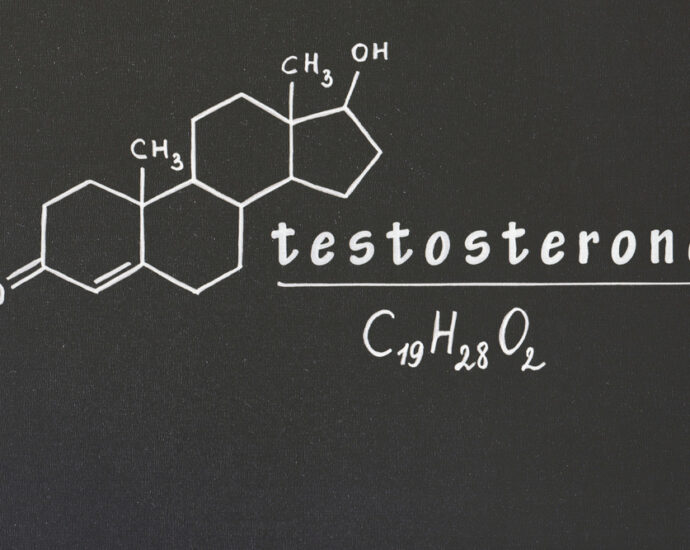Testosterone is a hormone that plays a critical role in the development and health of men. While both men and women produce testosterone, men have significantly higher levels, which are responsible for many of the physical, behavioral, and biological traits associated with male physiology.
Page Contents
What Does Testosterone Do in Men?
- Development During Puberty
- Testosterone surges during puberty, leading to:
- Growth of facial, body, and pubic hair.
- Deepening of the voice.
- Development of muscle mass and strength.
- Growth of the penis and testes.
- Increase in height and bone density.
- Maintenance of Adult Male Characteristics
- Testosterone is essential for maintaining features like:
- Muscle mass and strength.
- Healthy bone density.
- Distribution of body fat.
- Libido (sex drive).
- Sperm production and fertility.
- Energy levels and mood regulation.
- Mental and Emotional Health
- Testosterone influences:
- Cognitive functions like focus and memory.
- Emotional stability and resilience.
- Confidence and assertiveness.
- Metabolic Effects
- Testosterone impacts metabolism by:
- Enhancing fat burning and muscle preservation.
- Supporting red blood cell production.
Understanding Testosterone Levels
Testosterone levels are measured with a blood test and typically reported in nanograms per deciliter (ng/dL). The results help evaluate whether a man has normal, low, or high testosterone.
Normal Testosterone Levels
- For adult men (ages 19–39), the normal range is generally:
- Total Testosterone: 300–1,000 ng/dL.
- Free Testosterone: 5–20 ng/dL (unbound and biologically active).
What Do the Numbers Mean?
- Measures the total amount of testosterone in the bloodstream, including testosterone bound to proteins like sex hormone-binding globulin (SHBG) and albumin, as well as free testosterone.
- Free Testosterone
- Represents the small percentage of testosterone not bound to proteins, which is readily available for the body to use. This is often a more accurate indicator of hormonal activity.
- Bioavailable Testosterone
- Includes free testosterone and testosterone loosely bound to albumin. It’s a reflection of the hormone readily available to tissues.
Low Testosterone (Hypogonadism)
- Definition: Total testosterone below 300 ng/dL, or free testosterone below normal limits.
- Symptoms:
- Fatigue and low energy.
- Reduced libido and erectile dysfunction.
- Loss of muscle mass and strength.
- Increased body fat, especially around the abdomen.
- Depression, irritability, and brain fog.
- Reduced bone density (osteoporosis).
- Causes:
- Aging (levels naturally decline after age 30–40).
- Chronic illnesses like diabetes or obesity.
- Pituitary or testicular disorders.
- Medications or lifestyle factors like poor diet, stress, or lack of exercise.
- Treatment: Testosterone replacement therapy (TRT) or lifestyle changes.
High Testosterone
- Definition: Total testosterone above 1,000 ng/dL (rare without medical intervention or steroid use).
- Symptoms:
- Aggression or mood swings.
- Acne and oily skin.
- Increased risk of blood clots and cardiovascular issues.
- Testicular shrinkage (from steroid use).
- Causes:
- Anabolic steroid use or abuse.
- Tumors in the testes or adrenal glands.
Factors Affecting Testosterone Levels
- Age: Testosterone levels peak in the late teens and early 20s, then decline gradually.
- Diet: A balanced diet rich in proteins, healthy fats, and micronutrients supports testosterone production.
- Exercise: Resistance training and high-intensity interval training (HIIT) can boost levels.
- Sleep: Poor sleep, especially less than 7 hours per night, can significantly reduce testosterone.
- Stress: Chronic stress raises cortisol, which suppresses testosterone.
When Should Men Check Their Testosterone?
Men experiencing symptoms like low libido, fatigue, or unexplained weight changes should consult a doctor for a testosterone test. It’s particularly important for older men or those with risk factors like obesity, diabetes, or a history of infertility.
Conclusion
Testosterone is a vital hormone for men’s physical, sexual, and mental health. Understanding its role and what the numbers mean can help identify imbalances and guide appropriate interventions. Whether high, low, or within the normal range, maintaining healthy testosterone levels is essential for overall well-being.
READ MORE: Male Thyroid Problems: Common Signs and Symptoms You Shouldn’t Ignore
Sources:
https://www.health.harvard.edu/staying-healthy/testosterone–what-it-does-and-doesnt-do
https://www.urmc.rochester.edu/encyclopedia/content.aspx?contenttypeid=167&contentid=testosterone_total
https://healthsurgeon.com/calculate/body-mass-index/
